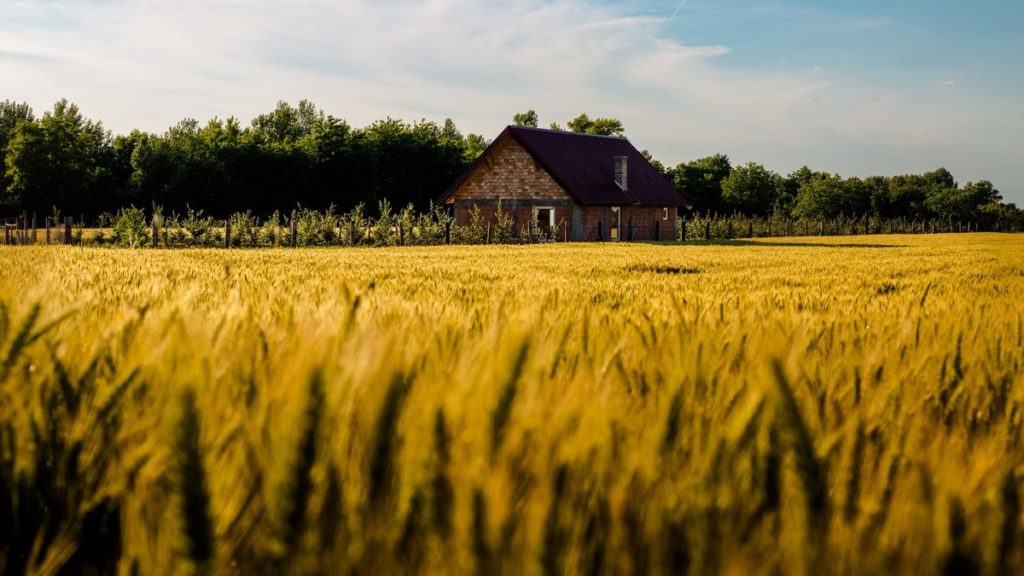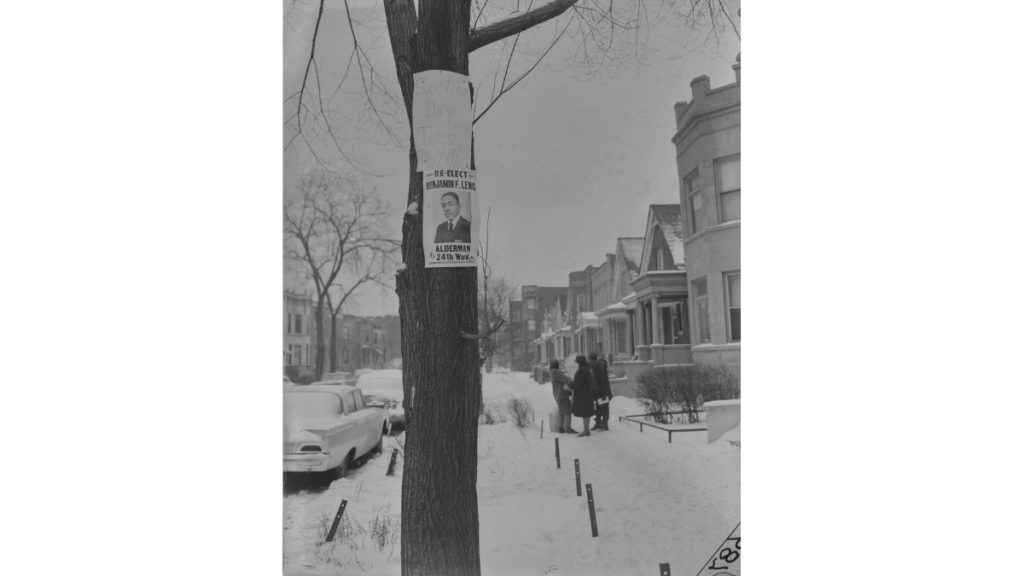Conservationists See Rare Nature Sanctuaries. Black Farmers See a Legacy Bought Out From Under Them

![]()
Conservationists See Rare Nature Sanctuaries. Black Farmers See a Legacy Bought Out From Under Them (Pembroke, IL) —
This story was originally published by ProPublica.
The Sweet Fern Savanna Land and Water Reserve, in the heart of Pembroke Township, Illinois, offers a glimpse into what much of the area looked like before European settlers drained swamps and cleared forests to grow corn and soybeans.
At least 18 threatened or endangered plant and animal species, including the ornate box turtle and regal fritillary butterfly, have been sighted here. Mature oaks tower over verdant fields of clustered sedge and Carolina whipgrass. Warbling songbirds and buzzing cicadas add a mellow soundtrack to the tranquil scene.
Sixty miles south of Chicago, this wildlife reserve is among nearly 2,900 acres owned by private individuals and environmental groups — most prominently, The Nature Conservancy — trying to establish a network of nature sanctuaries in Kankakee County. Their efforts have overlapped with those of the U.S. Fish and Wildlife Service, which two decades ago put forward a plan to buy up and preserve thousands of acres of what conservationists consider a rare habitat, one that includes the nation’s largest and most pristine concentration of sandy black oak savanna.
But these well-intended efforts overlooked a key consideration: the support of the residents of Pembroke and surrounding areas. Across the region, the acquisition of land by both the federal government and private conservationists occurred — and planning for more continues — in the face of persistent objections from local communities, including residents of this longtime Black farming community.
Founded by formerly enslaved people and later a haven for Black Southerners fleeing racial violence during the Jim Crow era, Pembroke became renowned as a symbol of Black emancipation and touted as one of the largest Black farming communities north of the Mason-Dixon Line. In its heyday, farmers and ranchers here not only raised their own food but supplied fresh produce to Kankakee and Chicago. Today, a small number of Black farmers are trying to hang on to what little they have left, while other parts of the township have struggled as well, with loss of jobs, a declining population and a crumbling village hall.
Some land for these nature sanctuaries was purchased at county auctions after local residents fell behind on their property tax payments, or from outsiders who picked up the delinquent parcels and flipped them, raising echoes of predatory practices that have long plagued Black landowners.
Adding to the opposition in Pembroke is the cold, hard math of property taxes. Newer environmental designations and restrictions have allowed outside groups to receive tax breaks that local elected officials argue are eroding an already precarious tax base.
The loss of Black-owned land in this community exposes a cruel irony. Pembroke has been one of the few places Black landowners could gain a foothold in Illinois, in part because this land was passed over by white settlers who presumed its sandy soils were worthless. And now, after generations without large-scale development or landscape-destroying corporate farming, this land has become sought after by outside conservationists because Pembroke’s savannas remain largely untouched.
Years of protest have done little to dissuade those pushing for more land to be dedicated for conservation.
Local residents have already seen what the future might hold. Most of the sites reserved for conservation ban long-standing local traditions like hunting and picking wild fruit, restrictions designed to remain in place forever, even if the land changes hands. In a community known for Black cowboys, new conservation-minded owners barred horseback riding but, in a couple of instances, protected the right to cross-country ski, not a popular pastime in Pembroke.
Before the arrival of private conservationists, there were no permanent legal restrictions on this land. And, in a place where neighbors knew each other, landowners permitted horseback riders to travel historic trails and passersby to pick wild blackberries regardless of property lines.
The tension has become an ongoing case study in how predominantly white environmental organizations and government agencies — willfully or not — can marginalize communities of color by prioritizing conservation goals over the wishes of residents.
For their part, the conservationists working in Pembroke say they are protecting the area’s most valuable resources and paying taxes on many properties after previous owners had fallen behind and contributed nothing. The Nature Conservancy has stopped buying at tax auctions and says it wants to learn from its experiences in Pembroke. “We understand that for our conservation goals to work in earnest, we need to listen to the residents who know their community best,” the conservancy said in an emailed statement.
But as conservationists and the federal government continue to press on toward their ultimate goal of preserving savannas, some Pembroke residents like Cornell Ward Jr. find themselves on the outside looking in.
One muggy and overcast July afternoon, Ward, a thin-framed 63-year-old man with salt-and-pepper dreadlocks, stood on a gravel road outside Sweet Fern Savanna.
Ward remembers a time when much of Sweet Fern Savanna belonged to Black farmers, including him. Peering beyond the barbed wire fencing and signs threatening to prosecute trespassers, he could see the patch of land where he once grew soybeans. The small patch of land — two adjacent parcels, totaling 3 acres — represented a chance for him to carry on a family legacy that extends back 60 years in Pembroke. Ill and unemployed, Ward lost his properties after he failed to pay $1,511.40 in taxes; they were purchased about a decade ago at county auctions by the preserve’s owner, an 85-year-old conservationist from Chicago’s south suburbs.
“How did they get all of this?” Ward wondered aloud.
Humble Beginnings and Lost Land
No one knows how Joseph “Pap” Tetter escaped the horrors of slavery in North Carolina, only that he, his wife, children and extended family arrived in what would become Pembroke Township in a wagon one day around 1861.
Tetter homesteaded 42 acres of land, which he parceled out and sold to fellow settlers. Proceeds went to help liberate more enslaved people via the underground railroad, according to oral histories.
Unlike the black, spongy soil that made Illinois an agricultural powerhouse, Pembroke’s sandy soil — widely considered some of the poorest in the state — didn’t retain moisture that would allow commodity crops like corn to thrive. But the land offered a fresh start for people who had been owned as property and forced to farm under threat of violence. Through trial and error, they found what could survive the sandy soil, growing specialty crops like okra, collards, peas and watermelons.
“It was available for African American farmers to come in and settle, because it wasn’t being snapped up by European American farmers,” said Mark Bouman, a program director at the Field Museum’s Keller Science Action Center in Chicago who has worked with residents, including a local project in conjunction with The Nature Conservancy, and has studied Pembroke’s history. “And so it was kind of like the leftovers.”
Ward’s family moved to the area in the late 1950s after briefly resettling in Chicago following the lynching of 14-year-old Emmett Till in their home state of Mississippi.
Ward’s father, a construction worker, used recycled lumber and materials to build the family’s house on land in northeastern Pembroke, where they raised chickens, goats, pigs and cows. Ward and his 10 brothers and sisters tilled the fields, sowed vegetable seeds and pulled the harvest from the earth by hand.
When Ward’s father died in 1999, he left no will. The siblings couldn’t agree on the fate of the property. Eventually, the family lost the land due to unpaid taxes. On his own, Ward still owned properties elsewhere in Pembroke but then lost those as well. Now some of that land is part of Sweet Fern Savanna.
Farming in Pembroke required long hours in the field, perseverance and faith; the small operations never yielded great wealth. But families carved out a modest living, enjoying the tranquility and spaciousness of the countryside.
Holding on to the land, however, proved tough. Pembroke’s farmers have suffered from the same racial inequities that permeate the American agriculture industry. Without capital or access to loans, they often used outdated equipment or planted by hand. Most farmed their land without irrigation systems, commercial fertilizers and pesticides — the hallmarks of modern agriculture. Many didn’t grow at the scale that would warrant crop insurance, leaving them vulnerable to drought or floods.
As time passed, Black farmers in Pembroke owned less and less land, due in part to financial hardship and lack of access to legal services that complicated the process of bequeathing property to heirs.
Their plight was not unlike that of other Black farmers across the country. In 1920, Black farmers owned about 15 million acres; by 2017, they owned around 4.6 million acres, according to a federal report.
In Illinois, an agricultural behemoth, Black-owned farms collectively make up only 18,659 acres — less than a tenth of a percent of the state’s agricultural lands.
Outsiders Gobble Up Acres
The push to preserve and restore rare natural habitats in Kankakee County, where Pembroke is the largest township by area, might have stalled out two decades ago if the only party interested was the federal government.
The U.S. Fish and Wildlife Service drafted the first plans to create a national wildlife refuge at the Illinois-Indiana border more than 20 years ago, but it was stymied when local residents raised objections and an Indiana congressman blocked federal funding. “We will not establish a national wildlife refuge here until we get funding from Congress, and Congress will not support funding unless the people want it,” Bill Hartwig, then-regional director of the service, told the Chicago Tribune in 1998.
There were no such promises from The Nature Conservancy, which had endorsed the federal plan and accumulated land on the Indiana side of the border. Without any announcement or public input, it began buying on the Illinois side too.
The Arlington, Virginia-based land trust has been praised for its efforts in protecting more than 125 million acres of land globally. But the organization also has been the subject of scrutiny for its real estate dealings.
A 1994 government watchdog report found some environmental land trusts, including The Nature Conservancy, had profited handsomely in some cases from selling land to the federal government. A 2003 Washington Post investigation found the organization had imposed permanent land-use restrictions on some of its properties to guard their natural features, but later sold the land to current and former trustees at reduced prices, some of whom built houses there.
The Nature Conservancy temporarily suspended that program and later announced it would cease selling land to its board members, trustees and employees altogether.
In Kankakee County, The Nature Conservancy started by purchasing 128 acres of forest on the edge of a large commercial farm in Pembroke for $183,000 in 2000. But much of Pembroke consists of tiny, slender tracts of land, meaning the organization had to work on a much smaller scale to expand its footprint.
Some of those tracts became available through public auctions of land lost due to unpaid taxes in Kankakee County. The Nature Conservancy said it has collected 201 deeds at tax sales, totaling 448 acres. It’s not possible to determine the race of all the former owners of the forfeited land, but the population of Pembroke is predominantly Black; local residents and politicians say most of the owners affected by tax sales were Black too.
Because the tax-sale properties tended to be small, those parcels made up less than one-fifth of the conservancy’s acreage in Kankakee County, according to the organization’s own figures. But, among local elected officials, the purchases raised questions about the ethics of buying land forfeited in financially distressed communities.
Those sales, along with the local belief that conservationists were serving as an extension of Fish and Wildlife, fueled a backlash. After an auction in 2015, The Nature Conservancy stopped buying through the tax sales.
That same year, Fish and Wildlife reemerged to reveal it would be pursuing the dormant plans for what it called the Kankakee National Wildlife Refuge and Conservation Area, and the next year it accepted a 66-acre donation to establish the refuge. (The refuge is intended to be primarily in Kankakee County, with a small portion in Iroquois County; the initial donation consisted of land in Iroquois.)
Sharon White, who was Pembroke Township supervisor at the time, joined with other area politicians from the U.S. Congress, the state legislature and local government to push back. The Kankakee County Board voted 22-2 in favor of a resolution objecting to plans for the refuge.
The Nature Conservancy, because of its deep pockets, drew special attention, and White met with conservancy officials.
In November 2016, White placed an advisory referendum on the ballot, asking: “Should The Nature Conservancy be allowed to purchase land within Pembroke Township to establish a conservation marshland?”
Voters left no doubt about their preference, answering “no” by a margin of 708-123. (The Nature Conservancy and its supporters say the vote was misleading because it misstated the type of habitat they are seeking to safeguard in Pembroke; conservationists want to protect savannas.)
“Coming from outside, assumptions were made by the conservation organizations that what they did for the good of the Earth, everybody would automatically love it,” said Bouman, the Field Museum director. “They’ve learned.”
In response to the local outcry, The Nature Conservancy took conciliatory steps, agreeing to temporarily halt land acquisition efforts for eight months. It also agreed to participate in ongoing efforts by the Field Museum and local residents in a Pembroke community planning project.
But conservancy leaders struck a different tone in emails with federal and state government officials. Those emails were obtained through a Freedom of Information Act request by ProPublica and examined for this story. Conservancy officials acknowledged the resistance from Pembroke residents and elected officials, but minimized the situation as a “melodrama” in internal documents circulated in a 2016 email.
In an email later that year, Fran Harty, then director of terrestrial conservation at The Nature Conservancy, urged Fish and Wildlife Service officials not to scrap the refuge plans despite community resistance.
“It is important that USFWS does not pull out all together because it will feed the
idea that all you have to do is throw a tantrum and USFWS will pack up and leave,” Harty wrote.
In 2017, Harty speculated how financial hardships for farmers might favor the group’s strategy.
“All it takes is two years of bad corn prices and it changes the chess board,” Harty told a Fish and Wildlife representative.
Officials from The Nature Conservancy’s Illinois chapter, including Harty, who retired in September, declined to be interviewed but provided a statement saying the organization will continue to work with residents of Pembroke toward its conservation goals.
“TNC does not tolerate environmental racism or injustice of any kind as we pursue our land and water conservation work in Illinois and across the world,” the statement said. “TNC’s pursuit of conservation must be inclusive and conducted with humility, trust, and respect.”
White remains skeptical of that commitment, even more so after learning of a 2015 email unearthed by ProPublica.
In 2015, while White was engaged in talks with The Nature Conservancy, she was behind on taxes for some of the parcels she owned in Pembroke. During that time, Harty shared a list of tax-delinquent parcels in Pembroke in an email to a federal official ahead of a county auction, with the note: “Fyi. I will let you know how this works out.” Highlighted in yellow were seven parcels owned by White.
In an interview, White acknowledged she was having trouble keeping up with her taxes due to financial hardship at that time. She paid her taxes, plus interest and late fees, to redeem the deeds before her properties were put up for auction.
In a recent interview, White said she had no idea that her properties, mostly wooded lots neighboring her three-bedroom home, had been discussed by The Nature Conservancy and Fish and Wildlife.
“They knew me and they were trying to buy properties from underneath me,” White said.
A spokesperson for The Nature Conservancy said the organization wasn’t interested in purchasing these parcels, and only highlighted White’s properties “on an information basis to show the areas that were tax delinquent.”
The recipient of the email was John Rogner, who at the time was a Fish and Wildlife Service coordinator. Rogner, now the assistant director of the Illinois Department of Natural Resources, declined to comment about the exchange, saying he did not recall the contents or context of the message.
Regarding the agency’s push for a national wildlife refuge despite the longstanding opposition in Pembroke and elsewhere in the county, the Fish and Wildlife Service said it has sought further public input and will be publishing a final planning report. The agency also emphasized that it will only buy land from willing owners.
“We want to create a sustainable plan for both people and wildlife,” Fish and Wildlife said in a statement. “This is a formative, collaborative process that’s mostly about listening.”
Rogner said that part of the federal process also includes working closely with private conservation groups. That’s what happened in Kankakee County.
“They had already brought under protection significant parcels of land,” Rogner said about The Nature Conservancy, “thus accomplishing some of what the service might have done under the refuge authorization. We coordinated with them in that they shared information about their land conservation so that we could better define what the service role should be.”
Fish and Wildlife also has a relationship with the Friends of the Kankakee, a nonprofit created by Marianne Hahn, the suburban woman who founded the Sweet Fern Savanna.
The group’s stated mission is to support the Fish and Wildlife Service and the Kankakee wildlife refuge. The 66 acres donated by Friends of the Kankakee turned the refuge from an idea to a reality.
A Way of Life Threatened
Pamela Basu, the eldest of the Ward children, is the only one who still owns land in Pembroke and farms there.
As she watches the conservationists buy up parcels and add restrictions, she sees a way of life disappearing.
When Basu was growing up, property lines meant little in a community where neighbors knew each other. Horseback riders followed historic trails. Hunters pursued wild game in the woods.
Basu belongs to a thinning cadre of elders trying to carry on the community’s traditions. She still walks the historic trail on her property, where she collects wild herbs and berries that she uses to concoct sauces, jams and tinctures. Each year, she hosts festivals featuring a farmer’s market, live performances and a nature walk.
“When I was growing up, you could walk from one end of the community to the other with trails,” said Basu. “You can’t walk through the woods anymore. You picked berries, herbs — you knew where things were. We’ve lost that part of our culture, and now you can’t pass that on to other generations.”
Outsiders are increasingly determining the future of the land. Over the years, commercial farmers and real estate speculators have purchased land lost or sold by Pembroke residents. In the past two decades, conservationists also took an interest in the area.
Even though conservationists share a love of the land with the farmers, they often have a very different view of how it should be used.
Among them is Hahn, a retired microbiologist. For years, Hahn volunteered at a nature area near her residence in Homewood, Illinois. But she was vexed by her lack of authority in the preserve. “If somebody wanted to put a trail right through the middle of a prairie, I couldn’t do anything about it. So I thought, why don’t I get my own nature preserve?”
Her larger goal: “My concept of all of this is that, in a small way, I’m saving God’s creation.”
A friend and fellow conservationist suggested she make a trip to Pembroke, an area with cheap land and abundant biodiversity. She did and was stunned by the rare prairie plants growing right along the roadside.
She bought 60 acres of land near the center of Pembroke Township two decades ago. This would become the foundation of the township’s first state-designated conservation area: Sweet Fern Savanna.
Creating the nature reserve meant that fields that once produced crops would need to be restored to their previous form. To Hahn, that made perfect sense.
“The parcels aren’t good for farming; people can’t make a living on them. They let them go for taxes — anyone can buy them,” said Hahn, who acquired a small number of the land parcels for Sweet Fern Savanna from auctions. “Should we not buy something that’s being offered to the public at an open auction?”
Over the years, the reserve has more than doubled in size. Signs mark the perimeter, warning, “No Horses. No ATV’s. Violators will be prosecuted.” The site is cordoned off by barbed wire fences, which Hahn said she installed after trash, including roof shingles, was dumped on her property.
Visits to the reserve are allowed only with Hahn’s written permission. For those she lets onto the property, Hahn permits them to hike, birdwatch, cross-country ski, camp and hunt. She said she allows one of her Pembroke neighbors to run his dogs on her property and a friend to hunt wild turkey and deer. Though she has chided trespassing horseback riders, she said, she has never prevented any of her neighbors from picking wild berries there.
Camping and cross-country skiing will no longer be allowed in 2026, according to state records that outline land restrictions for the site. Hahn has also included a special provision to allow a single burial site.
“It was not my intention to create a park. It was my intention to have a nature preserve,” Hahn said.
Hahn’s reserve is one of seven protected areas covering more than 1,100 acres in Pembroke. Five belong to The Nature Conservancy, and, like Hahn, the nonprofit has signed legal agreements with the state imposing some permanent restrictions on these properties in perpetuity with little, if any, public input. These designations are proposed by the landowner, then approved by the Illinois Department of Natural Resources and, in some cases, the governor.
Within the nature preserves created by the conservancy, hiking and sightseeing are allowed. But hunting, fishing, camping, campfires, motorized vehicles and horseback riding are not permitted. The preserves also permanently ban farming, agricultural grazing and time-honored traditions like harvesting wild fruit and plants. (Fish and Wildlife, meanwhile, does allow for wild herbs and fruits to be harvested on the acres it owns, after getting input from the community.)
At Tallmadge Savanna Land and Water Reserve, The Nature Conservancy permits cross-country skiing and deer hunting. But hunting privileges are only granted to those who have completed eight hours of volunteer conservation work.
Local residents wonder why recreation in these natural areas has to be limited.
“I haven’t seen any benefit to the community,” said White, the former township supervisor, who keeps horses in nearby Watseka, Illinois, which is in a different township. “I believe in conservation. There are national parks all over the country where there are hiking paths, horseback riding and camping. So why is it that is restricted to that extent in our community?”
What Is Best for the Local Economy?
The changes brought on by conservationists go beyond how the land is used.
After gaining ownership, conservationists have obtained state designations or imposed land restrictions that drastically reduce what they have to pay in property taxes.
The Nature Conservancy, for example, has enrolled some of its Kankakee County land in the state’s Conservation Stewardship Program, which allows the property to be assessed at 5% of its fair market value. Separately, conservancy land that is earmarked for nature preserves are only assessed at $1 per acre.
As a result, the nonprofit didn’t owe taxes on at least 38 of its parcels in 2020, comprising 382 acres, according to county tax records. That’s because the amounts owed are so small that the county treasurer doesn’t even send out a bill. In some instances, the conservancy pays less than the previous property owners were billed.
In a community where the median household income hovers around $29,000, local residents say it has been difficult to have land seized for failure to pay taxes and then see the new owners get a hefty tax break. In one instance, a Black farmer forfeited a 3-acre parcel of land in 2004 after falling behind on a $580.90 annual tax bill. The Nature Conservancy bought his land at tax sale, and two years later obtained a state conservation designation that allowed the organization to pay $19.60 annually in taxes — 96% less than the yearly amount the farmer lost it for.
But The Nature Conservancy argues that its presence can actually benefit local tax rolls, which can be hurt when landowners fall into delinquency. Organization officials say the group has paid more than $425,000 in county taxes since 2001.
Such arguments, however, have proved unconvincing in Kankakee County. Politicians and residents — Black and white — have strongly opposed conservation-related restrictions and tax breaks.
Antipathy has been especially intense in Hopkins Park because of the village’s desperate need to reverse years of economic stagnation and disinvestment. The conflict pits The Nature Conservancy, which in a 2019 tax filing reported $1.1 billion in revenue, against the mayor of a village that collected less than $37,000 in taxes for that year. Mayor Mark Hodge has led the chorus of naysayers who believe The Nature Conservancy moved too quickly to acquire land, undercutting local development plans along the way.
The conservancy purchased six parcels on Main Street, one of a limited number of places within the township served by water and sewer lines. It also bought land within several residential subdivisions. Though some of these properties were on major township roads, in some cases these areas still had a rural feel, marked by undeveloped land and trees.
“They bought property on our Main and Central streets,” Hodge said. “When they own the property, that means a house can’t go there, a business can’t go there because they are not willing to relinquish it. That would be tax revenue that we would receive for any water, sewer and other utilities. It’s unfortunate.”
He added: “It’s obvious that this is David and Goliath, the big guy trying to crush the small guy.”
The Nature Conservancy said it is unaware of any instances where its landholdings have blocked potential development. Conservancy officials said they considered selling one Main Street parcel to a developer interested in bringing a discount store to the site, but the developer withdrew for unknown reasons.
Hodge himself has picked up property this way, although he notes that the land he buys does not end up getting tax breaks in the ways conservationists have. He has been criticized within the community for his foray into commercial and residential real estate, but he says his personal investments also help the village by refurbishing properties.
In recent years, despite the legacy of farming in Pembroke, the community has become better known for its endemic poverty and lack of basic amenities. The township has lost more than half its population since 1980, and now has fewer than 2,000 residents. There are no grocery stores, pharmacies or banks in the 52-square-mile community.
Hopkins Park is marked with artifacts of disinvestment and broken promises. A factory building that once churned out military rations, and later products for Nestlé, is mothballed. Concrete silos sit abandoned on an unnamed road, the remains of a state plan to build an 1,800-bed women’s prison that officials predicted would bring 900 jobs to the area. The project was scrapped due to state budget constraints — after $13.2 million had been spent on site work.
Hodge said the constraints on development and the tax breaks amount to “community genocide.”
When landowners reduce or eliminate their tax payments, the remaining property owners in the tax district must pay more to make up for the lost funding needed for things like schools and roads, said Nick Africano, Kankakee County’s treasurer.
“These are communities that can least afford a hit to their school and village budgets,” Africano said. “They struggle for every nickel. I think it works for one set of people, and unfortunately most have no stake in our community.”
Still a Tension in the Air
In the face of intense criticism, The Nature Conservancy in 2016 invoked new principles and procedures for conservation in Kankakee County.
In addition to ending purchases of land through tax sale, the charity said it has been much more judicious with its land acquisition, ending the purchases of properties connected to village water and sewer lines — in other words, land that has development potential. Since its land-buying moratorium was lifted in late 2017, the organization has acquired roughly another 230 acres, most recently a 10-acre parcel in November 2020.
It now acknowledges that there have been missteps. “We want to … understand where we may have fallen short of our values, and adjust our approach where necessary,” the Illinois chapter said in an October statement to ProPublica.
Johari Cole, a Pembroke farmer, sees some hope in the adjustments made so far and said that disdain for the conservationists is misguided. She owns a home and 40-acre tract of land where she farms vegetables and raises goats. She’s also been an ardent supporter of environmental preservation, leading the Fish and Wildlife Service’s program to teach local adolescents about conservation in 2019. The agency, along with The Nature Conservancy, helped fund the program through the community nonprofit Cole runs.
Cole argues that the landholdings of private conservationists are dwarfed by the acreage held by outside commercial farmers. Like private conservationists, they, too, have also purchased tax-delinquent property at county auctions, contributing to Black land loss, Cole said. And because the assessed value of farmland in Illinois is based, in part, on soil type (and the soil in Pembroke is considered poor), they pay little in taxes.
“We’re dealing with two extremes: locking land up in conservation and locking in commercial ag,” said Cole, who is board president for the Community Development Corporation of Pembroke and Hopkins Park.
“I’ve told the mayor, you’ve got the same issue on both sides, but you’re only looking at one.”
The Nature Conservancy has cited Cole’s group as one of its local partners as it seeks community input. It also has worked with the Black Oaks Center for Sustainable Renewable Living, a nonprofit with the goal of reclaiming 1,000 acres in Pembroke for Black farmers, letting its apprentices farm on portions of conservancy land at no cost.
More recently, following questions from ProPublica about its activities in the township, the conservancy said it had assigned two top officials who specialize in diversity and equity to work with the Illinois team in Pembroke. There also will be a review of “our interactions with the community in Pembroke Township and the Village of Hopkins Park.” (The conservancy did not make those officials available to be interviewed for this story.)
In Hopkins Park, Hodge remains unimpressed by the conservancy’s efforts. He said communication still is lacking and the conservancy remains mum on basic information like how many acres it intends to buy.
Even though the conservancy is consulting with diversity and inclusion experts, “they are going against people’s wishes,” Hodge said. “The people have voiced their objection clearly. They do not want this refuge in our community. We want to set aside some land in the community for conservation. But we don’t want to set our community aside for conservation.”
His skepticism extends to government officials at the state and federal levels. And, across the region, tension ratcheted up again in recent months when the Fish and Wildlife Service moved forward on its large-scale conservation plans, after it found new funds for land acquisition beyond the original 66 acres.
In July, the service unveiled a plan for protecting and restoring up to 12,700 acres of land in an area that includes parts of eastern Pembroke Township, Momence Township and Iroquois County.
It didn’t take long for the Kankakee County board to once again voice its displeasure, passing a resolution that month to reaffirm its objection to the government’s plans in a 24-0 vote.
The service’s public meetings on its plans revealed a wide range of concerns from county residents. Among them: Roosevelt Smyly, whose family has owned land in Pembroke for more than 70 years.
He attended a Fish and Wildlife open house to voice his opposition. He feels that conservationists are insulting local residents with the implication that they are not capable of taking care of the land.
“That’s what really offends people like me,” Smyly, 71, said in an interview. “You’ve come from somewhere else and you’re going to upset the way that I live.”
Hoping and Praying
On a slate gray morning in late May, Robert Thurman Sr. grabbed a paper bag of string bean seeds and poured them into the hopper of a garden seeder. He lined up the two-wheeled contraption and leaned into it as he planted his first row.
Soon, six of Thurman’s children brought trays of burgeoning tomato plants from their greenhouse. They placed each in the ground by hand, watered them with a 5-gallon bucket and packed the soil tight around them.
Thurman’s family has owned land in the township for around 80 years. Skeptical of financial institutions, he only pays for farm equipment out of pocket. He typically buys older equipment for fear of being “tractor poor.” And he’s at the mercy of weather because he doesn’t have crop insurance in the event of drought or flooding.
“I’m hoping and praying to God that we can be on a bigger scale, because right now I can’t afford it,” Thurman said. “If something happens to my crop, it just happens.”
As the number of Black farmers in Illinois and across the country has tumbled, the state and federal government have said they want to stem Black land loss and encourage more diversity in agriculture. Gov. J.B. Pritzker brought a delegation to Pembroke earlier this year to acknowledge the racial disparities that exist in the state’s No. 1 industry.
“We have to face the often brutal history of why we work the land but no longer own or have access to the land,” said Lt. Gov. Juliana Stratton, the first Black woman in Illinois history to hold that role, standing before a podium in the gymnasium of a local elementary school.
It hardly makes any difference to Thurman. He had no idea the governor was in town and hasn’t paid a lot of attention to the controversy surrounding preservation. He knows there are no promises in farming. But so long as he has his land, it’s an opportunity he intends to pass down to his children.
“I’m going to live a certain way of life,” he said. “If it comes to a point to where they try to take me off my land, they are going to have to do a helluva move. Because I’m gonna be here as long as God sees fit to have me on this earth.”
Conservationists See Rare Nature Sanctuaries. Black Farmers See a Legacy Bought Out From Under Them








Responses